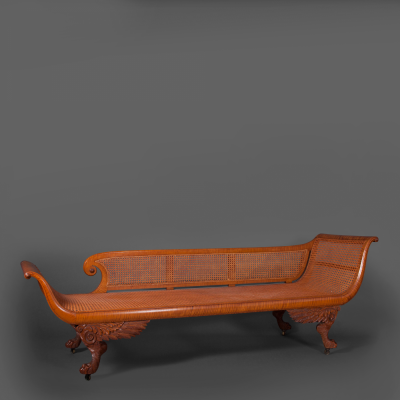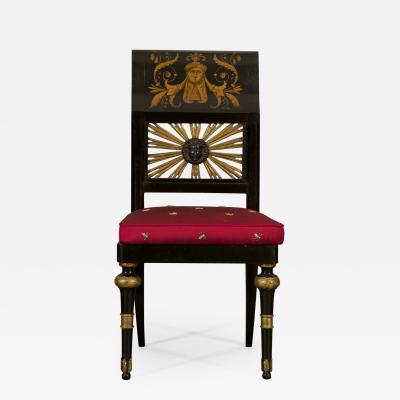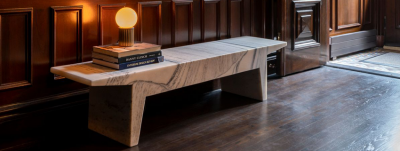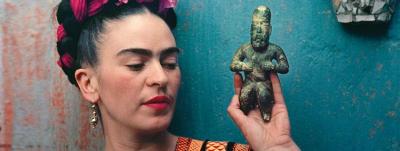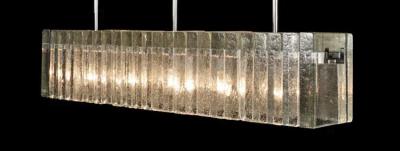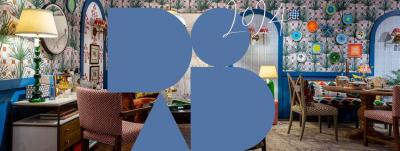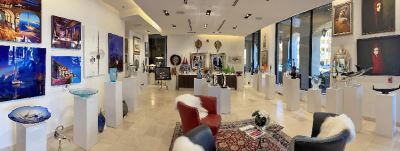John Aitken: The Scottish-born Cabinetmaker Creates Classical Philadelphia
Classical Splendor: Painted Furniture for a Grand Philadelphia House at the Philadelphia Museum of Art presents furniture designed by British-born architect Benjamin Henry Latrobe (1764–1820) for the house, also of his design, for Philadelphia merchant William Waln (1775–1826) and his wife Mary Wilcocks Waln (1782–1841). Situated on the southeast corner of Seventh and Chestnut Streets, the house was conspicuous in size, grandeur, and novel interpretation of classical revival architecture in early national America.
Lauded throughout the twentieth century as remarkable furniture with an early iteration of the klismos profile and surfaces lavishly painted and gilded in a fantastic classical lexicon (Fig. 1), the furniture has been newly researched by this author and treated by conservator Peggy A. Olley. It is now understood as an element of the sophisticated social theatre in the Walns’ house, which was torn down in 1847.1
A thorough reading of Henry Latrobe’s correspondence revealed the maker of the furniture to be John Aitken (ca. 1760/65–1839). Latrobe’s choice seems practical given the location of Aitken’s shop on the southwest corner of Sixth and Chestnut—the same block as the Walns’ house. Aitken’s shop orchestrated the construction of the furniture, and George Bridport (1783–1819), who was trained in London as a theatrical set designer and decorative artist, painted it. As an itinerant artist, Bridport worked wherever the commissions were, which in the case of the Walns was in Philadelphia. It is unknown whether he, Latrobe (or both) were inspired by painted furniture seen in Baltimore, where Bridport had received important commissions from Latrobe and others.
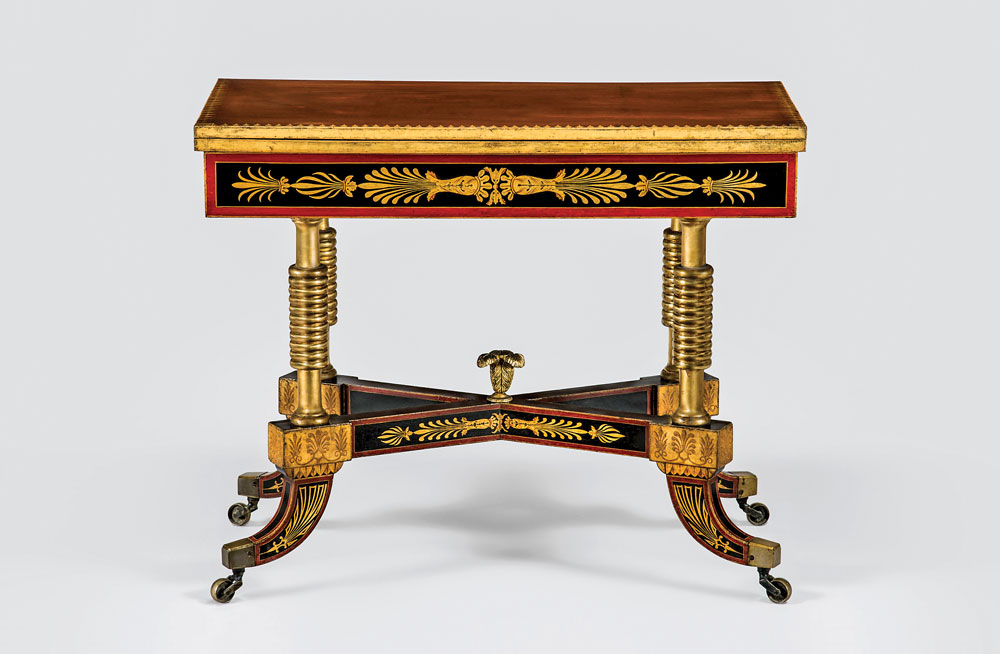
- Fig. 1: Card table (one of a pair), designed by Benjamin Henry Latrobe and attributed to John Aitken, painted and gilded by George Bridport. Philadelphia, 1808. Mahogany, tulip poplar, white pine, brass, gilded and painted decoration, iron, cotton velvet. H. 29-1/2, W. 36, D. 17-7/8 inches. Philadelphia Museum of Art; Purchased with the gift (by exchange) of Mrs. Alex Simpson, Jr., and A. Carson Simpson, and with funds contributed by Mr. and Mrs. Robert L. Raley and various donors (1986-126-1).
After nearly a year avoiding his commitment to design the Walns’ furniture, Latrobe finally focused on it as house construction neared completion. In August 1808, he met with the Walns in New York City to discuss the furniture for the two south-facing drawing rooms—one of which he designated as a dining room. Returning to Philadelphia, the architect wrote his wife, Mary Elizabeth, in Washington, on August 21, that he had completed his business with the Walns in New York.2 That same day he also wrote William Waln: “I shall see a pattern chair tomorrow morning. I have ordered the cushions to be takable off as I proposed. . . . The drawing of the sideboard goes to Aiken’s [sic] tomorrow morning.” 3 Here, Latrobe names John Aitken as the cabinetmaker responsible for producing the chairs and sideboard. Aitken also most likely made or oversaw the creation of the card tables, sofa (Fig 2), and smaller settees. The joinery and materials are consistent across the set and typical of contemporary Philadelphia furniture. The sideboard (Figs. 3, 3a) has long been termed a pier table—a much narrower form, usually between 36 and 40 inches wide—while this measures 61 ¼ inches wide, making it what the British called a sideboard and what continental Europeans called a console table. With its marble painted top and base and strong columnar supports, it is closely related not only to contemporary European examples, but also to ones made in New York. Later, one of the same form was made in Philadelphia for French émigré merchant Louis Clapier.
The custom design of the furniture added a layer of sophistication that the Walns could not obtain from the conventional repertoire of fashionable furniture then being made in Philadelphia, Baltimore, Boston, or New York. In many ways, the Walns’ furniture followed in the tradition of Baltimore, where elegant painted furniture with caned seats from the manufactory of brothers John (1777–1851) and Hugh Finlay (1781–1830) furnished that city’s Dancing Assembly rooms. But what Latrobe designed for the Walns was strikingly different—especially in form. In his chair design for Aitken, Latrobe abandoned the dainty columnar carved chair backs that were then in vogue, and drew inspiration directly from ancient examples, producing a more literal interpretation of the classical aesthetic.

- Fig. 2: Sofa, or Grecian Couch, designed by Benjamin Henry Latrobe and attributed to John Aitken, painted and gilded by George Bridport. Philadelphia, 1808. Tulip poplar, maple, gilded and painted decoration, iron, brass, replacement caning, modern upholstery. Philadelphia Museum of Art; Purchased with the gift (by exchange) of Mrs. Alex Simpson, Jr., and A. Carson Simpson, and with funds contributed by Mr. and Mrs. Robert L. Raley and various donors (1986-126-2a-c).
On August 25, 1808, Latrobe sent the Walns, who were still in New York, another update: “I never was less in a humor to design anything elegant in my life. My mind & body have been 150 miles asunder. However, I have designed a side chair & I think it will be tolerably handsome. It will at all events be new. But the pattern chair was the ugliest thing ever. I have ordered another pattern. To make a chair requires as much taste as to design one. Aiken has the sideboard already in hand.” 4 In this final surviving correspondence referring to the production of furniture for the Walns’ drawing rooms, Latrobe mentions another pattern chair, or prototype, for the set of klismos chairs that Bridport painted later that autumn. His quip that “it requires as much taste . . . to design” a chair as to make one underscores his struggle “to design anything elegant,” as well as the significance of successful collaboration with the maker—here, Aitken—in the execution. The pattern chair he references could be one of the PMA’s chairs, which is made of different woods, has tenoned joints secured with nails, and has slightly different dimensions, construction and decoration nuances (Fig. 4). Aitken’s klismos chairs, Grecian sofa, acroterion-ended settee, and French-style mirror-backed sideboard placed the Walns’ Philadelphia interior at the cutting edge of international fashion, as seen in the best drawing rooms of London, Paris, and Italy.
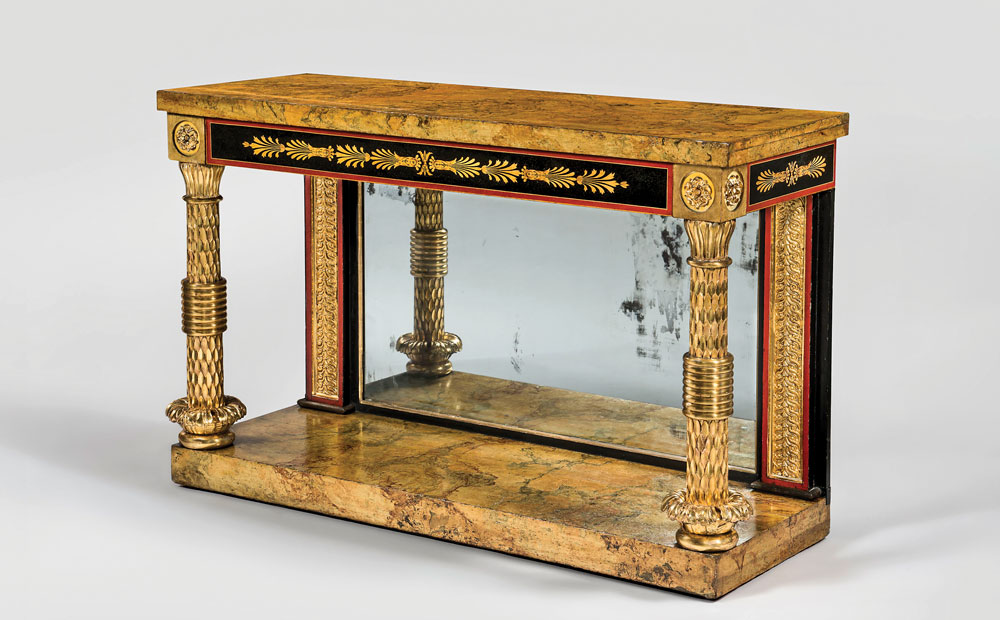
- Fig. 3: Sideboard, or Console Table, designed by Benjamin Henry Latrobe and made by John Aitken, painted and gilded by George Bridport. Philadelphia, 1808. Tulip poplar, probably pine, gilded and painted decoration, gilded metal rosettes, later mirror, cotton velvet. H. 41-1/4, W. 65-1/2, D. 23-1/2 inches. Inscribed “Thos Wetherill” on backing board and then “49 3/4 x 29” (which are the dimensions of the backboard); “A” on inside of back rail. Philadelphia Museum of Art; Purchased with the gift (by exchange) of Mrs. Alex Simpson, Jr., and A. Carson Simpson, and with funds contributed by Mr. and Mrs. Robert L. Raley and various donors (1986-126-7).
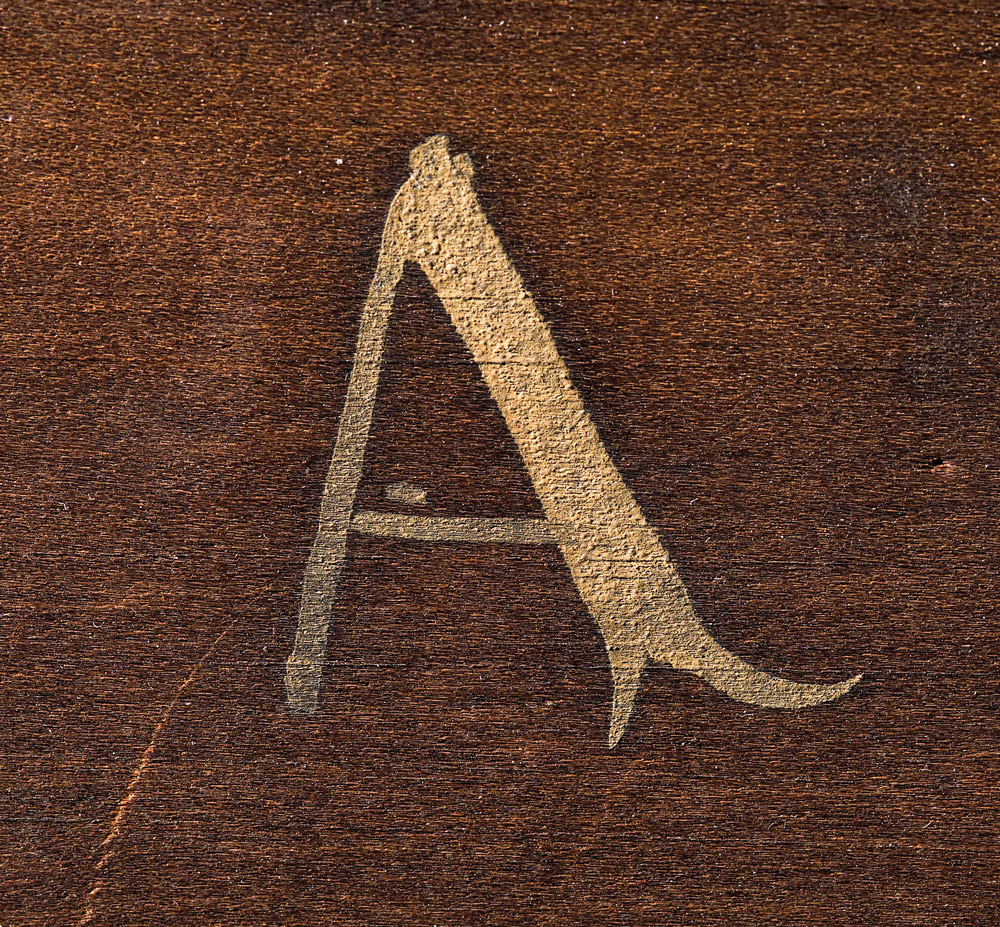
- Fig. 3a: The inside face of the rear rail of figure 3 is marked with the above letter “A.” While house carpenter Thomas Wetherill (1765–1824) inscribed, in graphite, the backboard of the back mirror that he framed, no other rails have a prominent block letter. Taken together with the documentary information, it may be a mark denoting that Aitken’s shop was the nucleus from which it was made—where many artisans came and went to work on the suite.
Facts about John Aitken’s early life and training remain vague. He was born in Scotland, probably between 1760 and 1765, though the exact location is not known. He first appears in the Philadelphia directory of 1785 as the proprietor of a grocery store with Joseph Ribaud (died 1801) at the corner of Second and Chestnut streets, and that same year he operated a cabinetmaking business two blocks east on Chestnut Street with the cabinetmaker Peter Ford (active 1785–1820, died 1820).5 Advertising as a solo proprietor in June 1790, Aitken gave what remains the only listing of furniture he made: chairs of various patterns, some of which are entirely new, never before seen in this city, and finished with an elegancy of stile peculiar to themselves, and equal in goodness and neatness of workmanship to any ever made here. Likewise, desks, bureaus, book cases, bed steads, tea tables, card ditto, dining ditto, &c.6
From his first shop at 50 Chestnut Street, Aitken led the city’s master cabinetmakers during a labor dispute that lasted from 1794 to 1796 and concerned the reissue of the book of prices that established fair wages for journeymen and reasonable retail prices.
Aitken became a member of the Saint Andrew’s Society of Philadelphia, a Scottish benevolent group, in 1794. On November 12, 1796, he married Jane McDowell (1774–1831), at New London, Pennsylvania. The marriage secured his social and economic position in southeastern Pennsylvania—and possibly provided professional connections since Jane was the daughter of Elizabeth Loughead McDowell (1738–1825) and Captain James McDowell (1742–1815), a prosperous, Irish-born merchant of Scottish ancestry who served gallantly in the Revolutionary War. His marriage to McDowell may have influenced George Washington’s choice of Aitken to make furniture early in 1797 when the former president and his wife prepared to return to Mount Vernon. Washington paid “John Aitkin for a desk for Miss Custis & a screen for Mrs. Washington” on January 18, 1797; $402.20 for twenty-four side chairs and two sideboards on February 21; and $145 for a tambour secretary on March 13.7 The sideboards and chairs were the centerpieces of Washington’s “New Room” at Mount Vernon, and the desk was for his plantation office—with the ensemble representing a paradigm for Philadelphia furniture of that period. Aitken’s chairs (Fig. 5), for instance, were derived from currently fashionable splat designs in Thomas Sheraton’s pattern book, but not progressive; however, he did show an enterprising side when, in March 1797, he advertised a considerable sum of mahogany and logwood for sale and his need to charter “a Vessel of 70 or 80 tons, to go two or three trips to Virginia,” presumably to deliver the Washingtons’ furniture.8 Such a venture almost certainly also speaks to his scouting for and pursuit of markets for his furniture in the active ports along the Potomac River.

- Fig. 4: Four Klismos Chairs, designed by Benjamin Henry Latrobe and made by John Aitken, painted and gilded by George Bridport, Philadelphia, 1808. Tulip poplar, oak (except 1986-126-7: maple, oak), H. 34-1/2, SH. 20, SD, 21 inches. Philadelphia Museum of Art; Purchased with the gift (by exchange) of Mrs. Alex Simpson, Jr., and A. Carson Simpson, and with funds contributed by Mr. and Mrs. Robert L. Raley and various donors, 1986-126-5-6. Gift of Marie Josephine Rozet and Rebecca Mandeville Rozet Hunt (1935-13-9-10).
While Aitken maintained his own shop at Second and Chestnut, by 1796 he was also seemingly carrying on a venture partnership with chair and cabinetmaker William Cocks (died 1799), trading in ports beyond Philadelphia under the name “Cocks & Co.” 9 The pair made “rich and Beautiful Furniture” in Philadelphia and shipped it to Charleston, South Carolina, where they advertised “A MOST elegant ASSORTMENT of FURNITURE, just imported from Philadelphia . . . a SIDE-BOARD . . . A TAMBOUR SECRETARY and BOOK CASE” (perhaps like Washington’s) and “Drawing-Room CHAIRS of new fashion, Mahogany CHAIRS, Together with WINDSOR CHAIRS of all colours.” 10 The advertisement also noted that the two men “had long experience in London,” a claim that cannot be ruled out. By 1798, Cocks and Aitken were operating a wareroom at Sixth and Chestnut as well as a shop at 79 Dock Street, closer to the waterfront, where they advertised old furniture to be traded in and houses to be furnished “by the week, month, or year.”
Cocks died in 1799 and named Aitken as co-executor with George Hog, the former Philadelphia cabinetmaker who was then working in his native Carlisle, Pennsylvania, a predominantly Scots-Irish settlement rife with cabinetmakers, including Henry Connelly (1770–1826) and Robert McGuffin (1780–after 1863).11 From 1800 Aitken operated out of the two shops that he had shared with Cocks—at 79 Dock Street and 34 South Sixth Street (also identified as Chestnut above Sixth Street and 145 Chestnut)—where he completed commissions for the City of Philadelphia and many of its most prominent citizens. In 1801, he took on George G. Wright as an apprentice. Wright trained with Aitken until at least 1805 and, in 1811, was the foreman in the shop of Joseph B. Barry (1757–1838) when he made a sideboard designed by George Bridport for William and Mary Waln.12 In 1806 a fire that started at the house “occupied by Mr. Vallence, Upholsterer, in Front-street, between Walnut and Chestnut-streets,” struck the Dock Street warehouse, and spread to Aitken’s shop.13 After the fire Aitken centralized his business at Chestnut and Sixth, from where he directed the making of the Walns’ furniture.14
By 1808 Aitken had enjoyed a thriving furniture making business for over twenty years in a tight, perhaps even saturated, Philadelphia market, and had earned a distinguished reputation among patrons and fellow makers. While he formed partnerships early on, his ability to lease and purchase properties suggests that he was possessed of capital—perhaps a reflection of his roots in Scotland, where cabinetmaking was often considered a gentleman’s trade.
Latrobe and the Walns would certainly have known Aitken’s shop at the east end of the Walns’ block on Chestnut Street. Proximity was not their only criterion, however, for the German émigré cabinetmaker William Spicekennaul operated a shop even closer to the house—at the southwest corner of Seventh and Chestnut.
The chairs, card tables, Grecian couch (consistently referred to by Latrobe as a sofa), and settee were progressive in their designs but did not combine the range of skill and materials required by the sideboard. For construction of the furniture to be properly coordinated, it would have required the expertise of someone of the caliber of John Aitken, who, with his shop men, constructed the furniture. They also would have overseen the caning of the seats for the sofas, chairs, and settee, as well as the upholstery by John Rea (1774–1871)—who applied the passementerie and fabric ends for the sofa and made the cushions—and the gilding and painting by George Bridport. Whether the sideboard moved between the shops is not known, but the work of the three artisans overlapped to such an extent that complete collaboration was necessary.
In the wake of the economic tumult that followed the War of 1812, Aitken advertised that he was leaving the cabinetmaking business to become a farmer.15 He and his wife and their four children moved to Chester County to maintain his wife’s family’s farm. This decision coincided with a changing tide in the art of cabinetmaking. Tools and techniques along with shop practice changed in Philadelphia, and a new style of furniture was on the rise. Many cabinetmakers flocked to Washington to help the city rebuild or ventured west to Pittsburgh or Cincinnati. On April 16, 1817, John and Jane Aitken sold some of their properties on Sixth and Chestnut to Thomas Hall for $16,500.16
Together with Latrobe, the Walns, George Bridport, and John Rea, John Aitken produced a set of furniture that transformed the artistic landscape of Philadelphia—and indeed America. The dramatic profiles of the klismos furniture heralded in a new style of furniture in the classical style—one that adhered closely to the furniture depicted in Greek and Roman art. By mid-1809, Latrobe had contracted with the Baltimore brothers John and Hugh Finlay, whose painted furniture manufactory thrived from 1804 until the 1830s, to create a closely related set of furniture for the President’s House of James and Dolley Madison. Like Aitken had a year earlier, the Finlays struggled to make the klismos form, and Latrobe wrote to Dolley Madison: “I had to design, and even lay out in the frame, the whole of the furniture of your drawing room, also a public concern. Workmen require constant watching in the commencement of work which is new to them. They must be taught like Children.” 17
Classical Splendor: Painted Furniture for a Grand Philadelphia House is on view at the Philadelphia Museum of Art through January 1, 2017. The exhibition catalogue by Alexandra Alevizatos Kirtley and Peggy A. Olley, which includes a detailed catalogue entry and further biographical information, is published in association with Yale University Press (2016). A symposium sponsored by the Center for America art at PMA and The Decorative Arts Trust was held on November 4, featuring Susan Buck, Gregory Weidman, Peter Kenny, Emily Erdmans, and Keynote Speaker Annabelle Selldorf, FAIA. For information on the exhibition and catalogue, visit www.philamuseum.org.
-----
Alexandra Alevizatos Kirtley is The Montgomery-Garvan Curator of American Decorative Arts at the Philadelphia Museum of Art.
Her select catalogue of the PMA’s early American furniture collection is forthcoming in 2020.
This article was originally published in the Winter 2016 issue of Antiques & Fine Art magazine, a fully digitized version of which is available at afamag.com. AFA is affiliated with Incollect.
2. Latrobe to Mary Elizabeth Latrobe, August 21, 1808, in Corr., vol. 2, p. 652.
3. Latrobe to Waln, August 21, 1808, in Papers, 65/F8.
4. Latrobe to Waln, August 25, 1808, in Papers, 66/A6. The sideboard’s unpainted top, base, and back could easily have been made in the four days between August 21, when Latrobe wrote to his wife, and August 25. However, it is likely that the plaster pilasters and rosettes were not yet ready and that the front columns would only have been in the rough, and required further embellishment, perhaps from Bridport upon his arrival in Philadelphia in October 1808.
5. The listing for Aitken and Ribaud in White’s Philadelphia directory of 1785 does not include a street number. The two men dissolved their partnership on October 19, 1785, and Aitken moved his cabinetmaking concern to that same location at Second and Chestnut; Pennsylvania Packet, October 25, 1785. It is not known exactly when Aitken and Ford dissolved their partnership.
6. Federal Gazette (Philadelphia), June 10, 1790.
7. George Washington House Account, February 21, 1797 (chairs and sideboards), and March 13, 1797 (tambour secretary), Mount Vernon. The tambour secretary, the chairs, and one of the sideboards remain on view at Mount Vernon.
8. Philadelphia Gazette, March 24, 1797.
9. Federal Gazette (Philadelphia), August 5, 1797.
10. City Gazette and Daily Advertiser (Charleston), September 14, 1798. While this ad does not mention Aitken by name, the two were partners by July 14, 1798, advertising that they had moved to 79 Dock Street, Aitken’s shop, from Cocks’ shop at Sixth and Chestnut (which Aitken would occupy after Cocks’ death in 1799, and from which Aitken made the Waln furniture). See Federal Gazette (Philadelphia), July 14, 1798. An October 1799 advertisement properly calls the partnership Cocks & Co. See Federal Gazette (Philadelphia), October 16, 1799.
11. Will of William Cocks, Wills for 1799, no. 195, Register of Wills and Inventories, County of Philadelphia, Downs Collection, Winterthur Library (959–1355). The accounts charge “To a dressing Table not included in the Inventory,” but the inventory does not survive. Also notably mentioned
are “a quantity of inlaid Shells.”
12. See Clark Pearce, Catherine Ebert, and Alexandra Alevizatos Kirtley, “From Apprentice to Master: The Life and Career of Philadelphia Cabinetmaker George G. Wright,” in American Furniture 2007, ed. Luke Beckerdite (Easthampton, MA: Antique Collectors’ Club), pp. 110–31 and Alexandra Kirtley and Peggy Olley, Classical Splendor: Painted Furniture for a Grand Philadelphia House (Philadelphia: PMA, 2016), catalogue no. 5, pp. 136–139.
13. Commercial Advertiser (New York), May 12, 1806. The proximity of the upholstery shop of John Vallence [also Vallance], a fellow Scot who joined the Saint Andrew’s Society in 1799, may suggest that the two worked on commissions together; Historical Catalogue of the Saint Andrew’s Society in Philadelphia, p. 91.
14. Aitken’s shop occupied a three-story brick building on a 640-square-foot lot on the southwest corner of Chestnut and Sixth streets. The shop was valued at $1,500 in the 1798 United States Direct Tax records—a sizeable amount given that Richard Peters’s nearby house at Walnut and Sixth streets occupied 2,160 square feet and was taxed at $2,500. Pennsylvania U.S. Direct Tax Lists, 1798, Ancestry.com.
15. Political and Commercial Daily Register, December 16, 1814.
16. Philadelphia County Deed Book MR13, p. 278, Philadelphia City Archives. Four more houses situated on that corner were included in Aitken’s 1839 will; Will 9879, written March 15, 1839, proven September 30, 1839, Chester County (PA) Archives.
17. Latrobe to Dolley Madison, September 8, 1809, in Corr., vol. 2, p. 761. See letter from Samuel Smith to Dolley Madison in which he advocates for Latrobe to choose the Finlays for the Madison commission. Smith to Dolley Payne Todd Madison, March 10, 1809, in The Dolley Madison Digital Edition, ed. Holly C. Shulman, http://rotunda.upress.virginia.edu:8080/dmde.


















